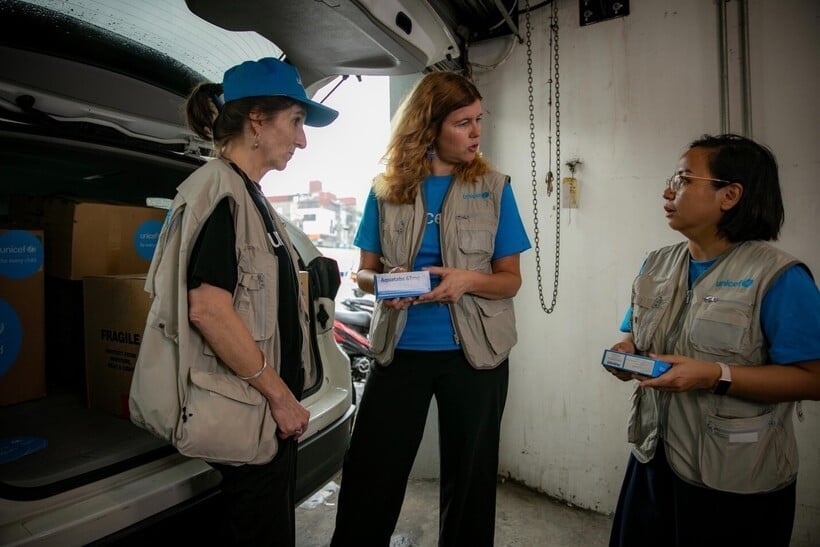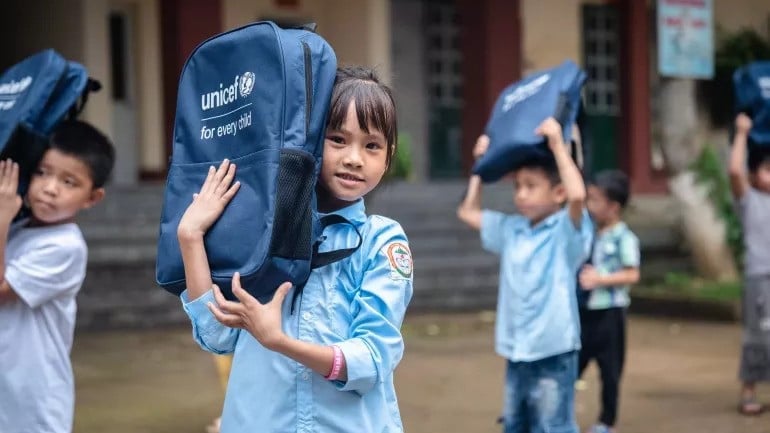November 19, 2025 | 07:48 GMT +7
November 19, 2025 | 07:48 GMT +7
Hotline: 0913.378.918
November 19, 2025 | 07:48 GMT +7
Hotline: 0913.378.918
As Viet Nam celebrates 80 years of independence, and UNICEF marks 50 years of partnership for children in the country, we reflect on a shared promise: a future where children grow up safely, healthily, and with hope and resilience - in the face of climate change and environmental challenges.
Viet Nam’s bold commitment to Net-Zero by 2050 is more than a policy goal. It’s a pledge to protect the next generation.
Last year, I visited several remote and disaster-affected communities, including those devastated by Typhoon Yagi. What I witnessed was both sobering and deeply moving. Families had lost their homes, schools were damaged, and access to basic services had been severely disrupted. Children faced interrupted education, limited healthcare, inadequate nutrition, and a lack of clean water and sanitation. The devastation was profound.
Children are especially vulnerable to climate impacts. They breathe faster, drink more water relative to their body weight, and depend on essential services — health, education, water, nutrition, and protection, that are increasingly under threat. Rising air pollution, saltwater intrusion, floods, and typhoons like Yagi are not just environmental events; they disrupt childhoods and threaten health, learning education, and safety of children.
Yet, climate action often overlooks children’s unique needs. That must change.

Ms Silvia Danailov (center) on a relief mission to communities affected by devastating Super Typhoon Yagi in Northern Viet Nam. Photo: UNICEF.
True climate resilience begins with protecting the systems children rely on. Water and sanitation systems must be built to withstand droughts and floods. Health and nutrition services, along with emergency planning, must be able to function under extreme conditions. Schools must remain safe during disasters.
But resilience also means addressing environmental health threats like air pollution. Ambient and indoor air pollution remains a major health risk in Viet Nam, especially for children. They inhale more pollutants per kilogram and have developing organs that are more sensitive to toxic exposure. Addressing air pollution is not only aligned with Viet Nam’s Net-Zero ambition — it is a moral imperative to protect future generations. Expanding community-based air quality monitoring, establishing national air quality standards and public reporting, promoting low-emission transport and renewable energy, and creating green zones around schools and hospitals are practical steps that can be taken now.
UNICEF has been working closely with national and provincial authorities to strengthen these systems. After Typhoon Yagi, we delivered emergency support worth over 180 billion VND to affected families. A few months later, I returned to some of these villages and saw the progress firsthand. Homes and schools had been repaired. Essential services, such as healthcare, education, clean water, and sanitation, were restored. Children received psychosocial support to help them heal from trauma. The joy in their eyes, the laughter and playfulness, the sense of normalcy returning - all were powerful reminders of what every child deserves.
But building back is not enough. We must shift from reacting to disasters to preventing them and to building back better - , by strengthening disaster risk reduction and preparedness and by integrating climate resilience into infrastructure, services, and governance.
Viet Nam’s climate commitments and leadership are clear. Its landmark pledge at COP26 to achieve net-zero greenhouse gas emissions by 2050 has not only been a decisive step to address the climate crisis - it is also promise to today’s children and generations yet to come. This promise has been enshrined in the National Climate Change Strategy. The country is phasing down coal-fired power production after 2035 and has launched a pilot emissions trading scheme, signalling a transition toward a carbon-neutral economy. Viet Nam has also joined the Just Energy Transition Partnership and endorsed global pledges such as the Glasgow Declaration on Forests and the Global Methane Pledge.
Government reforms, including streamlined governance and empowered local decision-making, are paving the way for more effective climate action. When communes have the authority and resources to prepare for and respond to disasters, they can protect lives and build resilience from the ground up.
As Viet Nam prepares its next Nationally Determined Contribution (NDC 3.0), it is essential to embed risk analysis focused on the most vulnerable, especially children, and to outline cross-sectoral solutions supported by innovative financing.

hildren at Phuc Khanh 1 Primary and Secondary School in Lao Cai Province receive school bags and essential school supplies through UNICEF's support. Photo: UNICEF.
UNICEF’s partnership with the Viet Nam Development Bank on the Net-Zero Climate Resilience for Children initiative is a model for combining environmental sustainability with tangible social benefits. By mobilizing resources from the Green Climate Fund, this initiative supports projects that protect children, families, and communities.
If we invest in climate adaption by making systems more climate resilient then children are better prepared for a future with increasing and intensifying climate threats.
To ensure long-term sustainability, financing mechanisms must prioritize the most vulnerable. Investment decisions should include child-focused criteria to ensure that resilience-building efforts truly reach those most at risk.
Yet, children are not only beneficiaries of climate action, they are contributors, innovators, and leaders. Viet Nam’s education sector is well-positioned to prepare children for a changing climate and to empower them to become leaders for change. By embedding disaster risk reduction and climate education into school curricula, we can build a generation ready to adapt and innovate.
Hearing and acting upon children’s voices on this topic is essential. The Voices of Green initiative, co-created by UNICEF, Young Pioneer and Children newspaper (Báo Thiếu Niên Tiền Phong và Nhi Đồng), and ToHe Social Enterprise, empowers youth aged 12–18 to share their perspectives, propose solutions, and engage with policymakers. Their ideas reflect community realities and help shape inclusive climate action.
Every decision we make should ask: Will this make life safer, healthier, and more hopeful for our children?
Viet Nam’s climate journey has been one of determination and progress. The next phase must be child-centred, safeguarding children’s rights and futures. It must be community-driven, empowering local actors to lead on resilience. It must be multi-sectoral, linking climate goals to health, education, WASH, agriculture, and protection. And it must be well-financed, leveraging national budgets, international funds, and responsible private sector partnerships.
The commitment to Net-Zero by 2050 is not just a national goal, it is a promise to today’s children and future generations. By protecting essential services, strengthening local capacities, and preparing the next generation to lead, Viet Nam can turn that promise into reality.
As we mark 80 years of progress and resilience, let this be the moment we unite to build a climate-safe future, one that is worthy of our children and of a proud, beautiful Viet Nam.

(VAN) Deputy Prime Minister Tran Hong Ha convened a meeting with the MAE and relevant agencies to discuss the draft decree on national multidimensional poverty standards for the 2026 - 2030 period.

(VAN) The year 2025 marks the 10th anniversary since more than 190 countries adopted the Paris Agreement on climate change, paving the way for strengthened global action.

(VAN) The PepsiCo Foundation funded the project ‘New Harvest: Sustainable Agriculture Initiative’, focusing on regenerative agriculture and climate change.

(VAN) Dr. Nguyen Viet Hung, ILRI's Regional Director for Asia, emphasized the One Health approach in ensuring food safety and reducing antimicrobial resistance risks in livestock.

(VAN) The youth-driven initiative ‘Innovate for water, act for the future’ seeks practical, scalable solutions to Vietnam’s water challenges.

(VAN) At the Annual Science Conference of Thuyloi University, Deputy Minister Phung Duc Tien directed researchers to focus on in-depth studies, data harmonization, and solutions linked to real-world practice.

(VAN) After nearly four years of implementation, 5,187 community agricultural extension groups have been established nationwide, with 47,493 members participating.